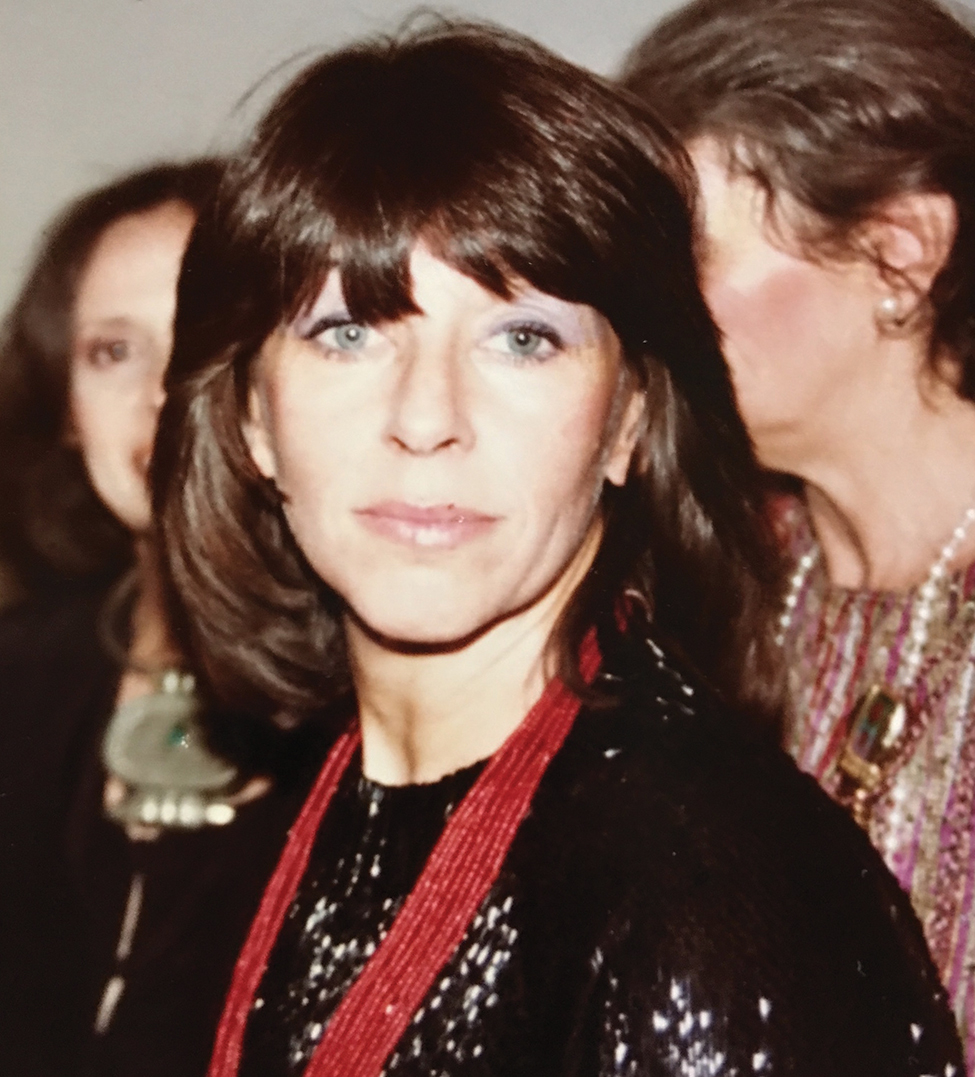Building a Next Gen Collection: Zach Smith

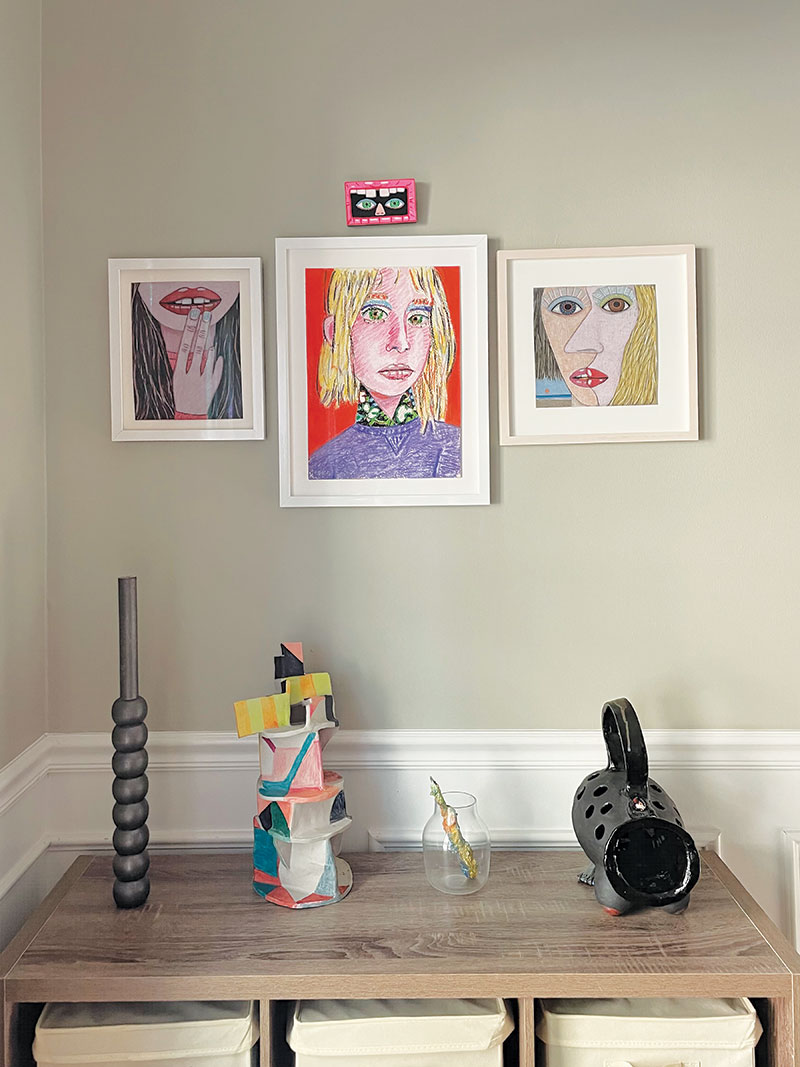
By BIANCA BOVA
To visit the home of an art collector for the first time is to ask to be surprised. Even more personal than the simple questions of taste and of what someone chooses to live with, there is the intimate question of how they live with art. When collector Zach Smith welcomed me into his family’s Chicago home, I found myself enthralled by the answers to both. Art is hung in nearly every room of the stylish two-story townhouse where Zach and his wife reside with their young children. Tucked away in a quiet enclave of the South Loop that borders the railway tracks, life in the Smith household unfolds alongside an art collection that is as historically fascinating as it is idiosyncratic.
Following a brief tour, Smith and I sat down in his dining room to discuss how his interest in art first developed, how he began collecting, and what advice he would give to other young collectors who have questions about navigating museums, the art market, and living with art and children under the same roof.

CGN: How did you first get interested in contemporary art, and what drove you to start collecting?
Zach Smith: I moved to Chicago in 2015 (I’m originally from St. Louis), and in 2018, I moved across from the Art Institute. I always liked art, but I hadn’t had the time to really focus on learning much art history. Living close to the Art Institute exposed me to a lot of great art and the way it’s carefully curated. I was hooked. That first year I literally must have gone a hundred times. I remember happening upon Kandinsky’s art and wanting to learn all about his movement and everything he was about. Then I kept going down rabbit hole after rabbit hole.
CGN: What was the first work that really captivated you?
ZS: Peter Blume’s painting The Rock was the first one to really wow me. His work is in some major collections–the Metropolitan Museum of Art, MoMA, and the Art Institute. However, his name is certainly not a household one today. His paintings metaphorically capture key moments in American history, especially related to World War II. The first time I saw The Rock, I really understood there are certain things that visual art can do that other media can’t. I learned to love visual art for what it can do without telling you something didactically. From there I became obsessed with Peter Blume. One day I thought, “What if I just Google how to buy a work of his?” Of course I was not thinking that I could ever really get one, because I assumed that art collected by a museum would be extremely expensive. But I happened upon a work on paper for sale online that was extremely affordable. I thought that was the coolest thing. I certainly didn’t set out to be a collector, I just thought, “Oh, wow, I can have a piece [of Blume’s] in my home!”

CGN: At the time that you acquired that work, did you have any idea how the commercial art market worked?
ZS: I knew absolutely, absolutely nothing. After getting the Blume work, I next did a lot of research to learn everything about how galleries work, how museums work, and where the major trends in contemporary art were. I was feeling like I started way too late in life, but I was probably around 30. I just felt like I was catching up for lost time. I still wasn’t thinking I wanted to be a collector, but I wanted to learn everything about the art world that I could. I have a background in business and economics, so the market aspect of it was really interesting to me. You can’t eat art, and it’s such a hard thing to price. So how artworks have an associated value and how they’re sold became interesting as well. Value is not as interesting as the art itself, of course, but interesting nonetheless.
CGN: What happened once you felt you had a better working knowledge of the art world and a grasp of its economics?
ZS: It was really through joining the Society for Contemporary Art (SCA), a group affiliated with the Art Institute, that I got some help in terms of navigating the gallery scene. SCA offered tours of the West Town galleries, and others, where you could meet and talk to dealers and artists at member events. I became familiar with people and spaces in the community, and then I started going to gallery shows and openingss on my own.
CGN: How did looking at art in galleries, instead of just museums, impact your perspective?
ZS: I started gravitating more towards abstract and conceptual art. And more contemporary. I started to learn which galleries I really gravitated towards, too. Some had amazing programs, but I found they just weren’t for me. Most of the work in my collection was made in the last five to ten years.
CGN: As you were developing your taste, did you come to a point where you ultimately did decide you wanted to be a collector? Or did you just continue to encounter works and realize you wanted to live with them?
ZS: I never thought in those terms. I still don’t, honestly. I’m fine with having an extremely eclectic collection. When I started, I would look into an artist a bit, but really I was buying what immediately struck me. I wasn’t really asking where a work fit into the artist’s wider body, who they were, what’s the philosophy, none of those things. It was just, “Wow, this piece is amazing. If it’s affordable, I want it in my home.”
CGN: When you were walking me through your collection, you made a remark about collecting deep versus collecting wide. There are a handful of artists in your collection where it feels like you’ve gone very deep into their practice. Was that a result of this realization?
ZS: I started collecting deeper with two artists in particular, Brian Calvin and Richard Tinkler, because I fell in love with their practice and I kept seeing works and saying, “These are the most amazing things I’ve ever seen.” I also realized there are so many artists out there whose work I want to live with and whom I want to support, that it’s more interesting and thought provoking for me personally to try to stick to having one or two examples of an artist’s work, versus deep collections.
CGN: Were you acquiring work primarily through the galleries you’d developed relationships with in Chicago?
ZS: When I started out, I was very New York focused, really just because New York has a great and well-known gallery scene. I was very aware of the, let’s call it, pedigree. I love Chicago. At the time it hadn’t occurred to me yet that I should be supporting Chicago galleries. I just thought the best of the best is what I want to go and see. I realized later, because of the Society for Contemporary Art and other groups, that there’s a lot of amazing work being shown in excellent galleries here. Once I saw enough Chicago galleries, I found the ones whose programs are right up my alley. I began to trust their programs and be excited by whatever they might bring to the table next. It’s not that I’ll never get work from New York, I still do occasionally, but I consider myself a very proud Chicagoan and also a lover of the Chicago art scene. So whenever possible, I prefer to acquire art via Chicago, just to do my small part to keep our system going.
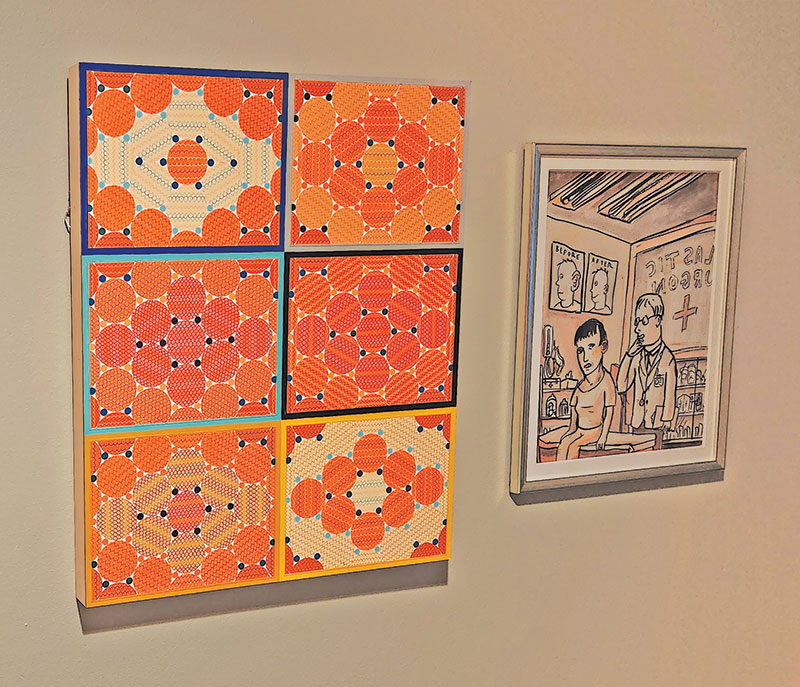
CGN: You have a number of modestly sized–almost unusually so–works by artists like Judy Ledgerwood, Rebecca Morris, and Rachel Harrison. What draws you to smaller pieces?
ZS: One, I’m naturally drawn to smaller works. I think it’s so cool that an artist can have a lifetime of thinking about art and developing their style and method over time, which they can capture that in a gigantic 90 x 72 inch painting or in a 14 inch ceramic sculpture. It just appeals to me to have the small one.
Corbett vs. Dempsey, a gallery I really love, would have a small sculpture and a small painting show every couple years. Those kinds of shows really knocked me out, since they distill an artist’s practice into very small works while still getting the big ideas across.
Number two, quite honestly, is economic. I think some people collect saying, “If I’m going to acquire from this artist, I want it to be a big, museum worthy, key work.” I personally would rather acquire what I can from an artist I love. If they have a very developed market, I would hope to get a small piece that is affordable for me and enjoy living with it, instead of feeling like I will only wait and hope I can get a masterpiece.
CGN: You referred to your collection earlier as rather eclectic. Now that you’ve been building it for a few years, are the common threads starting to reveal themselves to you?
ZS: There are a couple of common threads. Before I was interested in art, I was obsessed with music. I still am. Any artist that is navigating through both art and music, I’m naturally going to pick up on that. I have a Jason Moran that came from Luhring Augustine’s 2022 booth at EXPO hanging in my bedroom. He’s essentially dyeing a piano and playing it, putting a paper over the piano, and leaving marks on the piano through playing. I also have a great work on paper by Cauleen Smith that refers to a book she read and loved about the jazz great Charles Mingus.
I’ve begun recently to get into sculpture. I see something powerful about how a work can reside in space, how you can move around a piece and see it from different angles. You’re kind of on the same page with it–it’s an object, you’re an object, and you’re interacting and sharing space with it. A painting is static, stuck on the wall, so to speak.
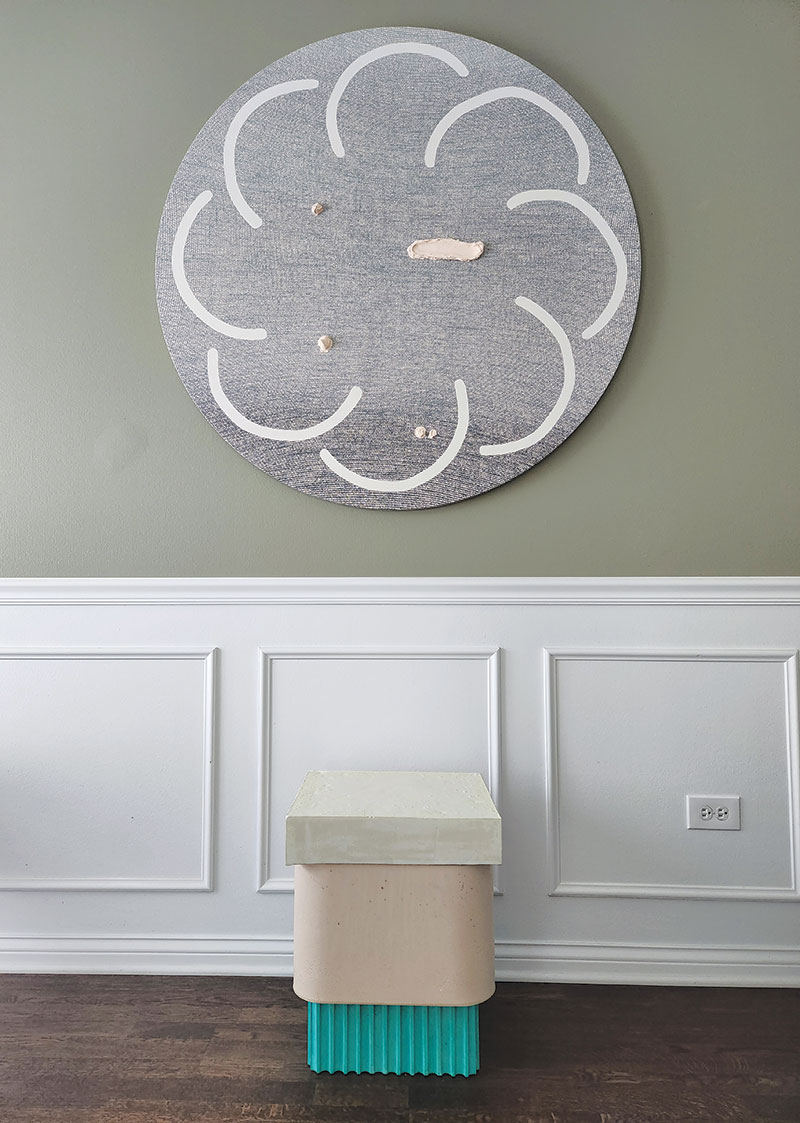
CGN: Has your relationship to your collection developed in the way you thought it would when you began?
ZS: That’s a great question. A sign of a great work for me, honestly, is if it’s visually dense and complicated and I know I’m not able to absorb it right away. If I’m going to go ahead and live with these works the rest of my life, I want something that will really unwind my eye over many years. That’s why I’ve grown a little less interested in figurative works. With a lot of figurative works, the image is kind of the thing. I like works that have a really long shelf life and that makes you work a little bit.
CGN: Your collection is hung throughout your entire home–kitchen, bathrooms, kids’ rooms. Have you always had that approach to displaying it?
ZS: Absolutely! It’s all about living with it, for me, my wife, and the kids. One part of that is training the kids at an early age not to touch the art and to keep it safe. Especially with some of the sculptures, the work can be very tempting. My daughter is now old enough that when I take her to the Art Institute, I can teach her not to touch any of the art. Except of course for Felix Gonzalez-Torres’s (Untitled) Portrait of Ross in LA, which you can take candy from. That one is confusing to explain to her in practice, but it’s candy, so she’s all about it.
I think many parents, and dads specifically, often want to get their kids into sports. For me, it’s art. I think that if my kids live with art from a young age eventually they’ll start to ask questions like “What was this artist going for? What did these colors mean? What do I take from this?” I fear the day when they are old enough to say, “Dad, I want to take this down and put up a poster.” That will make me sad because I think they have amazing art in their room, but it’s also exciting to think they’ll get to make up their own mind about what they want to look at when they’re older.
CGN: Are you the first art collector in your family? Do you see this as the start of a legacy for your kids?
ZS: Yes, as far as I know. And I hope so. The kids certainly don’t need to be collectors if they don’t want to be, but at a minimum, I want them to appreciate art and understand this is what contemporary art can be. I’m the only one who connects with every single piece in my home. It’s very much about my taste. If the kids don’t like it all, I hope it helps them learn why they don’t and it drives them to find other art that speaks to them. I’m trying not to force it, since when you do that kids sometimes just rebel against it. Ideally if they rebel against the art, it will just be my taste they rebel against. They’ll decide they love figurative realism, or come home saying “Dad, you’re crazy! Anna Weyant is the most amazing artist in the world!” And it’ll be, “Okay, that’s your taste. I’m glad you know what you like.”
CGN: You seem to really follow your instincts, but has the family legacy made you set any collecting goals?
ZS: Broadly speaking, I’d say to keep supporting local Chicago galleries, but that’s not a goal, that’s something that gives me a warm, fuzzy feeling. My walls are already fairly full, so I can’t say I have my eyes on some giant painting, because there’s nowhere for it to go. I never think in terms of, “Oh, this is a gap in a collection, I need to fill it,” if that’s what you mean, which is definitely a valid style of collecting, just not mine. It’s fun for me as a collector to not have a roadmap because I’m more open to discoveries that were not on my radar. It’s great when you never thought you would like something that you end up loving.
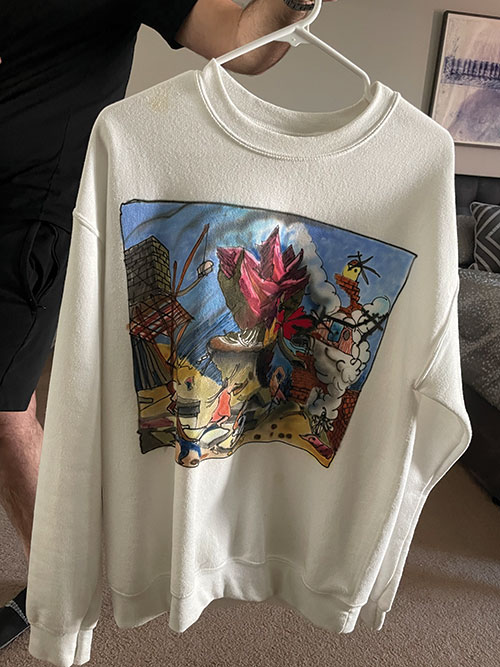
CGN: What works have surprised you in that way?
ZS: Well, this is related to a change in how I’ve collected over time. I was much more Instagram-focused in the very beginning. It can be a great tool for discovering all kinds of art, don’t get me wrong, but it can be overstimulating. You see so much, but it’s mostly surface level.
There was a time when I was following hundreds and hundreds of artists and overwhelming myself, frankly, but it is how I found an artist named Kate Klingbeil. She had a post that said “For $100 you name a painting and I will paint a version of it on a sweatshirt you can wear.” As I mentioned, The Rock by Peter Blume was a work that blew my mind. It was so special to me. I thought let’s see if Kate would be up for doing this one. I reached out and she responded, “Well, this is actually one of the trickier ones anyone has asked for.” There’s a lot going on in it, to be fair–a lot of figures, some strange angles. Blume was inspired by Renaissance perspectivism. Ultimately Kate agreed and did a phenomenal job. I have an artwork I can wear as an homage to the first piece I ever really loved. I definitely did not set out looking for it, but it’s something that ended up being very meaningful.
CGN: If you take Peter Blume to start, what do you see as the furthest point your taste has expanded to now?
ZS: I’ve gotten away from the mentality that it’s not art if it’s not a painting on a wall. There’s a piece in Portugal now, at DOCUMENT’s Lisbon gallery, by Kiah Celeste. She makes these outstanding sculptures that utilize found objects. This one is an exercise ball that’s been compacted within a flue liner from a chimney. There’s nothing technically difficult about it, or intricate, or anything like that, but it is this perfect idea, executed. I think that’s what I gravitate towards now–work that seems totally fresh and shocking to me.
CGN: Of the more traditional works you have, many are by Brian Calvin. What drew you to his work?
ZS: His use of color is outstanding. He captures a very dry California kind of mood. Brian was one of the first artists I came across where his practice was coherent, in the sense that he generally does one thing, and he does it perfectly. In this case, it’s these stylized portraits of women. Brian focuses on the formal qualities of portraiture, of how you can take the same style, and evolve it over time. I think of his work as really direct. He’s also obsessed with Bob Dylan, and I am as well. I love those kinds of connections with artists.
CGN: I noticed an almost spiritual aspect to some of the works you own as well.
ZS: There’s a soft spiritual aspect, definitely. I think some artists can’t help putting all of themself into a work. I have a Cauleen Smith sculpture, an incense burner. She had this vision of this parade or procession that these incense burners would be used for. It’s not just going out to create a sculpture. It’s starting with the feeling or the idea and then the sculpture is the outcome. Same with this Gordon Hall stool. It comes out of ‘How can I make a functional piece you’re a uncertain about?’ You’re not really sure if it’s furniture or not. I love art where the artist’s values are afforded to me.
CGN: What guidance would you offer to young collectors, or collectors of any age who are just starting out?
ZS: My advice is: Don’t buy anything for six months. If you’re really into art, start by going to as many gallery and museum exhibitions as you can. See what curators are interested in, and how they are telling stories of what’s going on. See what artists and dealers are excited about. You need to learn as much as possible and develop your own taste. When I first started, I liked almost everything. There is so much great art in the world, but over time you realize this period or these groups of artists, or whatever it is personally is what shines above the rest. It took me months to get there. You really have to–as nerdy as it may sound–study as much as you can. When you feel like you have your taste going, then you start acquiring. If art is something you’re even 2% interested in, pursue it. It’s a huge payoff intellectually, socially, and emotionally, once you commit yourself to it.
#
